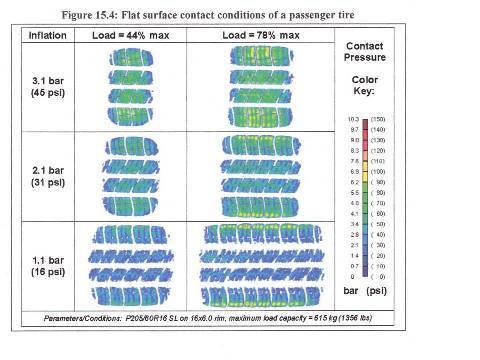I hope everyone will understand that a lot of posts were directed my way - and rather than answer them individually, I'll put them all in one post:
Quote:
Originally Posted by natefish

Perhaps the article was accurate in 2005 when it was published. Mr. Storton seems to have a pretty good list of qualifications after his name, I doubt he just made stuff up for fun.
Can you provide the source the makes you think he is wrong?.....
|
The article was inaccurrate in 2005.
Tire Guides - which is a publication that summarizes the vehicle tire placard information for all vehicles sold in the US - has this listed for a 2005 Ford Crown Victoria - 4 versions:
Crown Victoria Police Special: P225/60R16 97V 35 psi front and rear
Crown Victoria: P225/60R16 97T 32 psi front and rear
Crown Victoria LX: P225/60R16 97T 32 psi front and rear
Crown Victoria Sport: P235/55R17 98H 35 psi front and rear.
I went back in model years, and it says something similar back as far as the 2000 model year.
Bottomline: Sgt. Storton did not present correct information at the time he published his article. And he could have prevented that mistake by simply visiting a Ford dealer.
Quote:
Originally Posted by orange4boy

...................Oh, I know what I'm looking at. Those are woven steel wire belts that run around the circumference of the tire. The individual wires are angled, yes, but as a whole they run around the circumference of the tire. ...
|
First, they are not woven. They are parallel individual strands - which is why there are 2 layers, one going one way and one going the other way.
Yes, they are circumferential, but so are the plies.
The point is that the radial plies are going to try to form a circle (in cross section) when subjected to pressure. The belts
resist this, but do not
prevent it. The net result is that increasing the inflation pressure tends to shift the pressure within the footprint from the shoulders towards the center - in other words, towards the direction of forming a circle in cross section.
Here's something that says this is true:

If the principle is true, then we also ought to see it in the real world - and we do. The problem is that there are other factors which affect tire wear more dramatically, so this tends to get disguised and lost, but it does appear clearly from time to time.
Quote:
Originally Posted by orange4boy

......I agree there is a difference between some guy's opinion and solid, good information. That's why I found scientific and government studies as well as textbook references that support my positions.
You have yet to do so. ....
|
Oh, how quickly we forget. Remember this?
Quote:
Originally Posted by CapriRacer

|
Or this?
Quote:
Originally Posted by CapriRacer

|
Contrary to your assertion, I have been providing documentation.
So now what? Personally, I think the list needs to be reviewed to see if each item is properly documented - and whether there is any contradictory information.